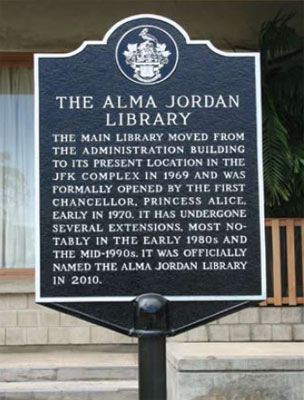 |
 |
 |
|
January 2012
|
Lady of the libraryBy Professor Bridget Brereton
In October 1960, the Imperial College of Tropical Agriculture (ICTA) was merged into the UCWI as its Faculty of Agriculture located at its second campus, St Augustine. Enter a youthful Alma Jordan. She was not yet Campus Librarian – UCWI had only one Librarian, at Mona – but whatever the formal titles she held, she was effectively in charge of the new Campus Library from 1960 until her retirement in 1989 (by then she was both Campus and University Librarian). It fell to her to lead the transformation of the small, highly specialised ICTA collection into a library for a growing campus serving many hundreds, soon thousands, of students reading for degrees in several faculties and departments. With the opening of the Faculty of Engineering (1961) and even more the College of Arts & Sciences (1963), almost suddenly, with very little lead time, the Library had to cater for about 2,000 students and teaching staff (1966) in many different subjects never before taught at St Augustine. The size of the overall collection doubled between 1960 and 1966, but the book collection more than trebled. All this in the same place, the grand old Administration Building, which got so hopelessly overcrowded that the Registry and Bursary had to be temporarily “evicted” in 1967-69 so that the Library (previously only on the top floor) could occupy the ground floor too. Jordan and her devoted staff in the 1960s had to scramble to acquire the materials needed for all the new degree programmes, often bearing the brunt of hardly fair criticisms from the academics with their usual high expectations. It had to be done with inadequate funds, staff, and basic bibliographical tools. Moreover, Jordan had to create a management structure and units with specific functions from scratch, for the ICTA Library had really been a one, or at most two, woman show. The ICTA collection had to be reorganised, reclassified, and partially integrated with the new Natural Sciences division. A crazy time (Jordan’s phrase) indeed; but, as a postgraduate student on campus in 1968-72, I can testify that the challenge was met more successfully than anyone had a right to expect.
If anyone thought that with the beautiful new Library up and running, Jordan and her staff could relax in the next decades, they were wrong. St Augustine was in permanent expansion mode, especially in the buoyant years of the first oil boom and just after, and the Library was forever playing catch up. The first of two major extensions took place in the early 1980s, catering mainly for increased student numbers in engineering and the sciences. Jordan recalled the first extension, which she and Zaffar Ali as campus planning officer managed, as “a huge headache,” especially as the Library had to remain open all through. Another “headache” was automation, which began in the 1970s and continued through the 1980s in an often painful trial and error process. Gradually loans and other key operations were computerised using the VTLS software. Student and staff unrest was another potential headache in the 1970s and 1980s, with nervous days for Jordan and her staff especially in 1970, and on several occasions then and later the Library had to be closed to protect its precious contents. All in all, Alma Jordan’s 30 years at the helm of the Campus Library were both extraordinarily challenging, and extraordinarily fruitful. A true institution builder, when she retired in 1989 she could look back with pride on her many achievements, and forward with confidence that her successors as top managers would continue the tradition of dedicated service she had established, and that our Library would continue to be the heart and soul of the campus. |

 During the celebrations to mark the fiftieth anniversary of the St Augustine Campus in 2010/11, it was decided to rename some buildings to honour staff members for their outstanding contribution to St Augustine’s development. The first to be officially renamed was The Alma Jordan Library (previously The Main Library) at a function on February 28, 2011.
During the celebrations to mark the fiftieth anniversary of the St Augustine Campus in 2010/11, it was decided to rename some buildings to honour staff members for their outstanding contribution to St Augustine’s development. The first to be officially renamed was The Alma Jordan Library (previously The Main Library) at a function on February 28, 2011. No section of the St Augustine community was more relieved when the JFK Complex was completed in 1969 than the Library. Jordan had been closely involved in the design of the new building, and she managed the complicated logistics of the move from the Administration Building, which took place during the long vacation of 1969. With minimal disruption of service during the move (again, I distinctly remember this myself), the new building opened its doors to students in October 1969. St Augustine finally had a university Library worthy of the name, and it has remained the flagship of the Campus ever since.
No section of the St Augustine community was more relieved when the JFK Complex was completed in 1969 than the Library. Jordan had been closely involved in the design of the new building, and she managed the complicated logistics of the move from the Administration Building, which took place during the long vacation of 1969. With minimal disruption of service during the move (again, I distinctly remember this myself), the new building opened its doors to students in October 1969. St Augustine finally had a university Library worthy of the name, and it has remained the flagship of the Campus ever since.